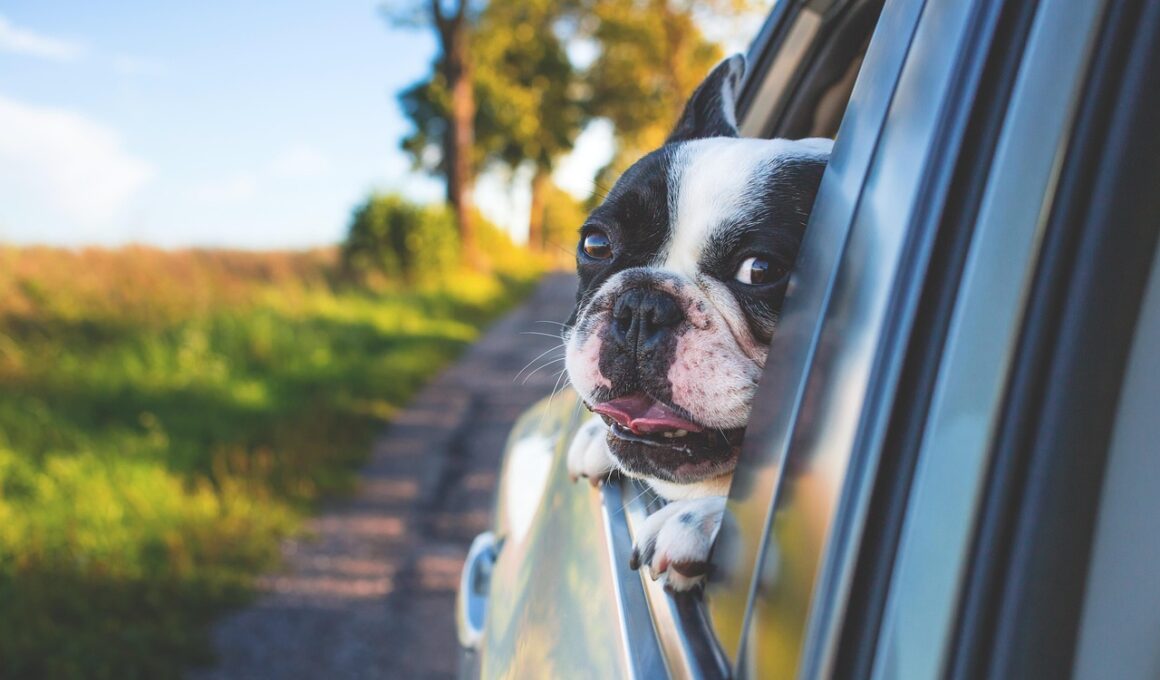Understanding and Managing Dog Anxiety During Travel
Traveling with your dog can be a delightful experience, yet it often comes with challenges, especially regarding anxiety. Many dogs feel uneasy during transit, whether in a car, plane, or even in a new place. This anxiety can manifest in several ways, including whining, barking, or restlessness. The first step to managing this anxiety is understanding what triggers it. Common triggers include unfamiliar environments, the motion of vehicles, or lack of familiar scents and objects. As a pet owner, it’s essential to recognize these triggers to help alleviate stress conditions. One effective method is gradually introducing your dog to travel experiences before embarking on longer trips. For example, start with short car rides. Gradually extend the duration as your pet becomes more comfortable with these journeys. It’s critical to ensure your dog has their favorite toys, blankets, or beddings with them to provide comfort. Regular breaks during travel allow your dog to stretch and relieve themselves, further reducing anxiety. Ultimately, preparation and patience are key to a peaceful trip with your furry friend.
Implementing calming techniques can also significantly reduce dog anxiety during travel. Techniques such as desensitization and counter-conditioning can help alter your dog’s negative associations with travel. For example, if your dog associates the car with a trip to the vet, they may become anxious once they recognize the vehicle. Counter-condition your dog by taking them for enjoyable car rides that end in fun places, like parks. Additionally, calming aids such as anxiety vests, pheromone diffusers, or calming music can help soothe your pet during travels. Consult with your veterinarian about medication options that may help if your dog’s anxiety is severe. Remember that no two dogs are alike; thus, what works for one may not work for another. Always be attuned to your dog’s individual reactions and adjust your approach accordingly. Having patience is critical; training may take time. Keep your sessions short and positive to avoid overwhelming your dog. With time and consistency, most dogs can learn to travel without excessive stress, leading to more enjoyable experiences for both of you.
Preparing Your Dog for Trips
Preparation is crucial when traveling with dogs. Familiarizing your dog with the travel environment can ease potential anxiety. Start by creating a positive association with the carrier or vehicle used for traveling. Allow your dog to explore these spaces freely, rewarding them with treats or favorite toys to create a positive experience. Practice loading them into the car and taking short trips to gradually accustom them to longer journeys. Ensure they are comfortable and secure in their space, using harnesses or seatbelts specifically designed for dogs. A well-ventilated, shady area in the vehicle can significantly enhance their comfort levels. It’s equally important to plan your stops during travel. Frequent breaks will help your dog relieve themselves, hydrate, and stretch their legs, greatly reducing their overall anxiety. Ensure you carry plenty of water, food, and any necessary medications along with your pet’s favorite toys or items that may help calm them. When it’s time to load onto a plane or train, check local regulations and prepare your pet accordingly for travel requirements.
Managing your dog’s anxiety during travel also extends to their behavior in unfamiliar places. Upon reaching your destination, allow your dog to acclimate to the new environment. Begin by gradually introducing them to different areas of your accommodation. Let them explore while on a leash, ensuring they feel secure within their new surroundings. Create a dedicated space with their bed and belongings to help them feel settled. This comforting zone serves as a retreat when they feel overwhelmed. Observe how they react to various stimuli, such as new sounds, sight, or smells. It may take time for them to adjust; being patient during this transition period is vital. Reinforce positive behavior through treats and praise when they remain calm. Socialization with other pets or humans should be approached carefully; always gauge your dog’s temperament before introducing them to unfamiliar animals. As they adapt, you’ll notice your dog becoming more relaxed and confident. Maintain a routine, including regular feeding and walking schedules, to provide a sense of familiarity amidst the changes.
Utilizing Professional Help for Severe Cases
If your dog’s anxiety continues to be an insurmountable problem, consider seeking professional help. Veterinarians or certified pet behaviorists can provide valuable insights into managing severe dog anxiety. They may recommend various options, such as training programs or behavioral modification therapies, that work specifically for anxious pets. Utilizing products like calming pheromones or engaging in specialized training can often lead to improved travel experiences. It’s essential to also explore alternative therapies that might aid in managing anxiety, such as acupuncture or massage therapy. These holistic approaches may offer your dog comfort during stressful travel experiences. Each dog is unique, and different methods may work better for individual pets. Consultations with experts may lead to tailored solutions that cater to your dog’s particular needs. Keeping an open line of communication with your veterinarian can help address ongoing concerns to adapt your approach accordingly. Remember, addressing severe anxiety may require a multi-faceted approach combining multiple strategies for optimal results. Ensuring a safe and reassuring environment is ultimately the goal for both you and your beloved pet.
Always prioritize your dog’s comfort and well-being throughout the travel process. Consider using a secure and comfortable crate for car travel and for hotels when necessary. Familiarizing them with their crate at home teaches them that it is a safe space. Equip the crate with their favorite bedding and toys. Avoid feeding them a large meal right before travel to prevent motion sickness. Instead, offer small snacks during the journey, and hydrate them consistently. Being aware of the weather conditions also helps you make travel preparations. Ensure your dog is not exposed to extreme temperatures, especially in hot summer conditions. Moreover, always carry a pet first-aid kit equipped with essential items like band-aids, antiseptic wipes, and any medications they may need. Many travel destinations offer pet-friendly accommodations, so researching and planning ahead increases the likelihood of a positive experience. Understand that, just like humans, dogs experience fatigue during travel. Always be prepared to provide breaks and relief when needed. Ultimately, with effective planning and understanding of your pet’s needs, traveling with your dog can be a rewarding and enjoyable experience.
Conclusion
In summary, dog anxiety during travel can cause distress for both pets and their owners. Being proactive in preparing your dog for travel will ease anxiety significantly. Understand their triggers, and slowly acclimatize them to travel, whether you’re embarking on a short road trip or a long air journey. Employ calming techniques, utilize familiar items, and maintain an open line of communication with veterinary professionals as needed. Always create a secure environment and maintain routines to keep your dog grounded amidst the changes. On the journey, remember the importance of taking breaks and ensuring regular comfort measures to promote a peaceful atmosphere. Consult experts when faced with severe cases of anxiety, as there are various methods available to address specific challenges that arise. Each journey can become a joyful adventure instead of a stressful ordeal with the right mindset and preparation. Your dog relies on you for guidance and support throughout their travels, and it’s essential to be attentive to their needs. Ultimately, fostering a happy, healthy travel experience for your furry friend enhances the bond you share.
Final Thoughts on Traveling with Dogs
Ultimately, enhancing your dog’s travel experience can significantly improve their overall happiness and well-being. Preparing for travel with your furry friend is essential, and employing effective strategies to mitigate anxiety does wonders for creating a positive experience. Whether you’re embarking on a long-distance journey or a relaxing weekend getaway, forethought goes a long way to ensure your dog feels safe and secure throughout the trip. Emphasizing the importance of training, ample breaks, regular routines, and unyielding patience equips your dog for successful journeys. Lastly, remember that every dog has unique needs, and personalization through observation and understanding is vital to managing anxiety effectively. Keeping the methods discussed in mind, embark on your travel adventures armed with techniques and preparations to promote a positive atmosphere for your dog. With the right approach, travel together can evolve into cherished memories to last a lifetime.


